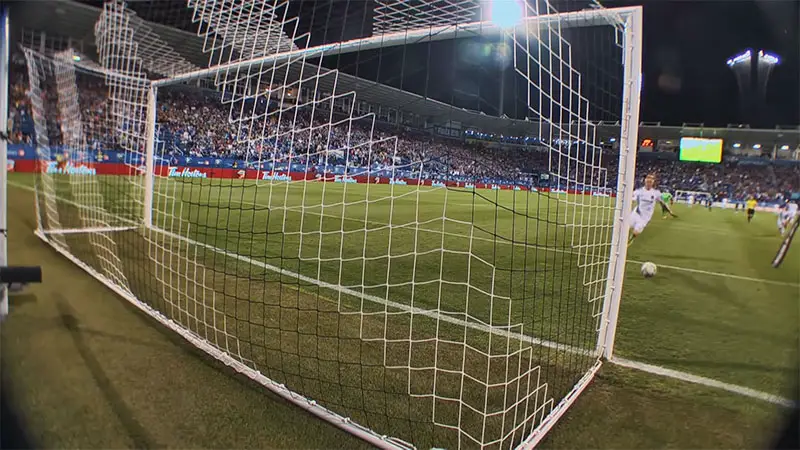When you’re watching a soccer match, the goal line is where all the action happens. It’s the boundary that determines whether a team scores or not, making it a critical part of the game. But have you ever wondered about the specifics of how it’s marked and why it’s so important?
A soccer field’s goal line isn’t just a random line; it’s precisely measured and regulated. According to FIFA and US Soccer, the goal line must be shorter than the touchline and is typically 4 to 5 inches wide.
This line, along with the goal area extending 6 yards into the field, plays a crucial role in defining the goal zone. Understanding these details can deepen your appreciation for the game and its intricacies.
Explained: The Vital Role of the Soccer Goal Line
The goal line is a critical element in soccer, directly impacting the outcome of a game. Knowing its exact definition and key measurements helps you better understand the game’s dynamics.
Definition and Significance
The goal line lies between the goalposts and spans the width of the goal area. It plays a vital role in scoring, as a goal counts only when the entire ball crosses this line. Referees use this line to judge goal situations and make decisions that affect the game’s result.
Key Measurements and Markings
The width of the goal line is typically 4 to 5 inches (10-12 cm). This width ensures visibility to players, referees, and spectators. For international matches, goal lines measure between 70 to 80 yards (64-75 m) in length.
These measurements allow for a standardized play environment regardless of where the match occurs. Using proper marking tools like aerosol spray cans ensures these lines remain clear throughout the game.
Technology and the Goal Line
Technology now plays a significant role in ensuring the accuracy of goal-line decisions in soccer.
Goal-Line Technology Explained
Goal-line technology (GLT) uses advanced systems to verify whether the ball has crossed the goal line. Initiated to address controversies and inaccuracies in goal-scoring decisions, GLT offers a reliable solution.
Various systems exist, such as GoalControl and Hawk-Eye. Each uses distinct methods like cameras or magnetic fields to make precise determinations.
How It Works: An Overview
GLT employs multiple high-speed cameras or sensors positioned around the goal. These cameras or sensors track the ball’s movement in real-time.
When the ball crosses the goal line completely, the system notifies the referee instantly, typically via a vibration and visual signal on a wristwatch. This immediate feedback ensures decisions are quick and accurate, drastically reducing the margin for error.
Major tournaments, such as the FIFA World Cup and the UEFA Champions League, have successfully integrated GLT to enhance the game’s fairness and integrity.
History of Goal-Line Technology
Soccer has evolved significantly with the introduction of Goal-Line Technology (GLT). This advancement ensures accurate goal decisions, enhancing the fairness of the game.
Early Development and Trials
Efforts to create reliable GLT began in the early 2000s. FIFA initiated trials using various systems, including Hawk-Eye, which originally served cricket and tennis. Initial tests involved placing cameras around the goal area to track the ball’s position.
Germany’s Bundesliga and England’s Premier League were among the first leagues to experiment with GLT. These trials revealed the technology’s potential to determine whether the entire ball had crossed the goal line, assisting referees in making precise decisions.
Implementation in Major Competitions
After successful trials, FIFA and other major football associations adopted GLT for major tournaments. The 2014 FIFA World Cup in Brazil marked the first World Cup deployment of this technology, using GoalControl’s system with 14 high-speed cameras around the pitch.
By December 2014, Germany’s Bundesliga adopted GLT, selecting the Hawk-Eye system. Subsequently, Ligue 1 followed, initially choosing GoalControl for the 2015-16 season before switching to Hawk-Eye in 2018 due to performance issues.
GLT is now a standard in many top-flight leagues and tournaments, ensuring clear, indisputable goal decisions and reducing refereeing errors.
Controversies and Criticisms
While Goal-Line Technology (GLT) has brought precision, it hasn’t eradicated all disputes. These controversies revolve around the integration of technology in a traditionally human-judged sport.
The Debate on Human vs. Technology
You encounter a persistent debate regarding whether human judgment or technology best serves the game’s integrity. Proponents argue that human referees add an element of unpredictability and tradition.
However, critics highlight frequent refereeing errors, such as the disallowed goal in Germany’s 4-1 victory over England during the 2010 FIFA World Cup. They contend that GLT reduces these mistakes, offering objective decisions that enhance fairness.
Notable Failures and Resolutions
Although mostly successful, Goal-Line Technology has had its shortcomings. Instances like the failure of GLT to signal clear goals in the English Premier League prompted questions about its reliability.
These failures push authorities to continuously refine the system, ensuring it meets the highest accuracy standards. Enhancements and rigorous testing have since mitigated many of these issues, reinforcing GLT’s credibility in crucial moments.
Impact on Soccer Competitions
Goal-Line Technology (GLT) has significantly transformed soccer competitions, ensuring fair play and accurate goal decisions.
Effects on Game Dynamics
GLT impacts game dynamics by providing instant, accurate goal decisions. This reduces disputes and interruptions, maintaining the flow of matches. Consequently, players and coaches adapt strategies, knowing that goal-line decisions are precise.
The technology’s presence also influences referee confidence, enabling them to focus more on other aspects of the game.
Reactions from Teams and Officials
Teams and officials have mixed reactions to GLT. Proponents argue it enhances fairness in matches, citing fewer controversies over goal decisions as evidence.
Critics, particularly some traditionalists, express concerns about over-reliance on technology, fearing it could diminish the human element of refereeing. Despite differing opinions, most acknowledge GLT’s role in improving overall match accuracy and fairness.
Frequently Asked Questions
What is Goal-Line Technology (GLT)?
Goal-Line Technology (GLT) is a system used in soccer to determine if a ball has completely crossed the goal line, thereby assisting referees in making accurate goal decisions.
Which systems are commonly used for GLT?
Systems like GoalControl and Hawk-Eye are commonly used for GLT, employing cameras and advanced software to ensure precise goal-line decisions.
Where has GLT been successfully implemented?
GLT has been successfully implemented in leagues such as the Bundesliga and the Premier League, as well as in major football tournaments.
What are some controversies associated with GLT?
Controversies include debates over the reliability of technology versus human judgment, and instances of system failures, like those witnessed in the English Premier League.
How does GLT impact soccer matches?
GLT provides instant, accurate goal decisions, reducing disputes and interruptions, and ensuring fair play in soccer matches.
Conclusion
Goal-Line Technology has revolutionized soccer by ensuring accurate goal decisions, reducing disputes, and enhancing the game’s integrity. The technology supports referees by easing pressure and minimizing errors, fostering a fairer and more exciting soccer experience.
Its successful implementation sets a standard for other advanced technologies in the sport, resulting in global improvement in match quality and viewer satisfaction.
Ultimately, investing in Goal-Line Technology preserves fair play and promotes further technological advancements in soccer. With continuous innovation, Goal-Line Technology can become even more precise and integrated with other systems like VAR.








Brice Petersen